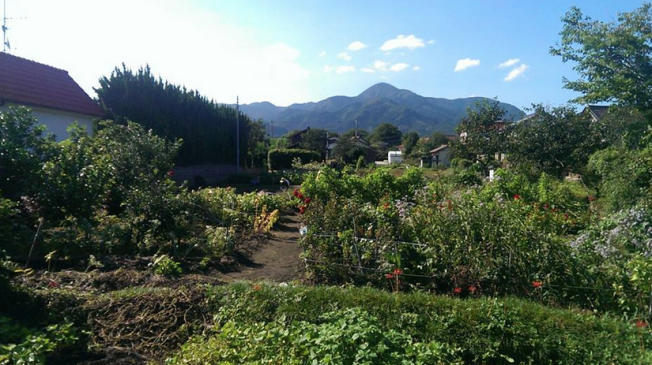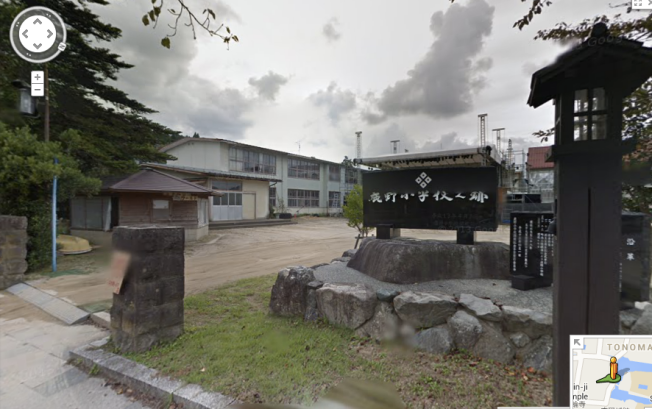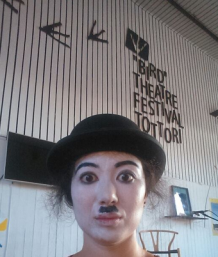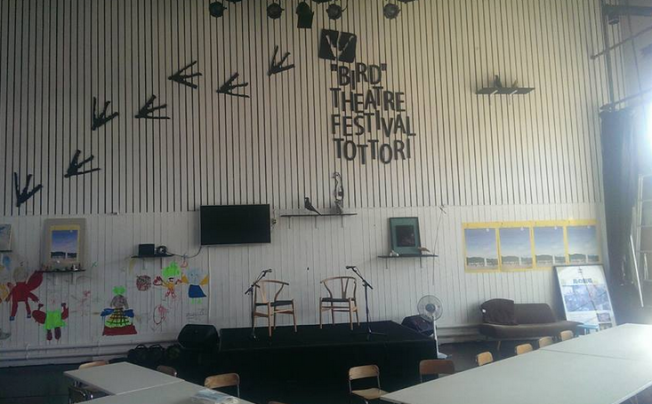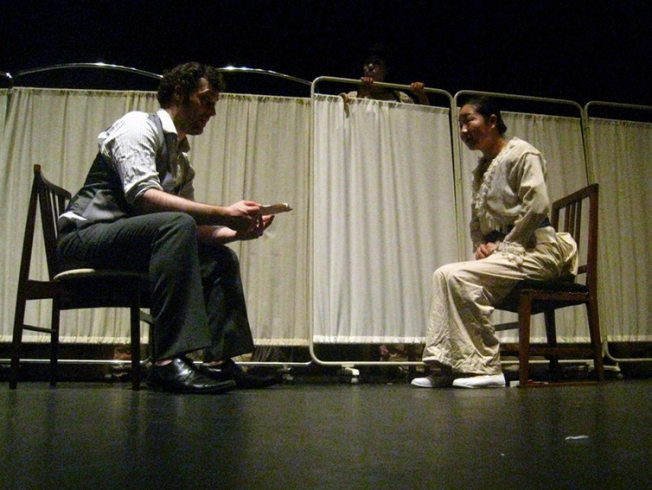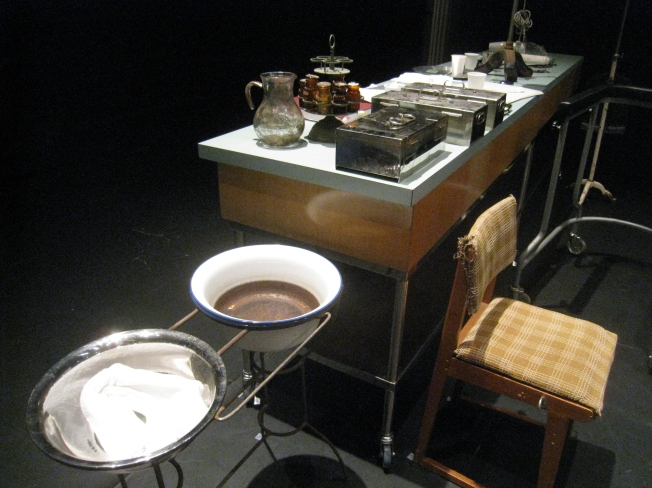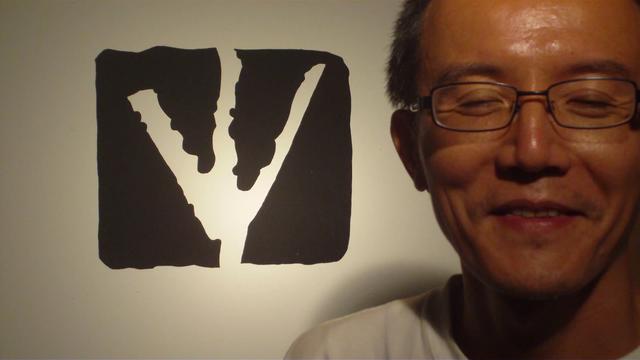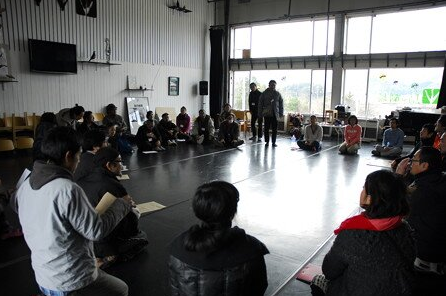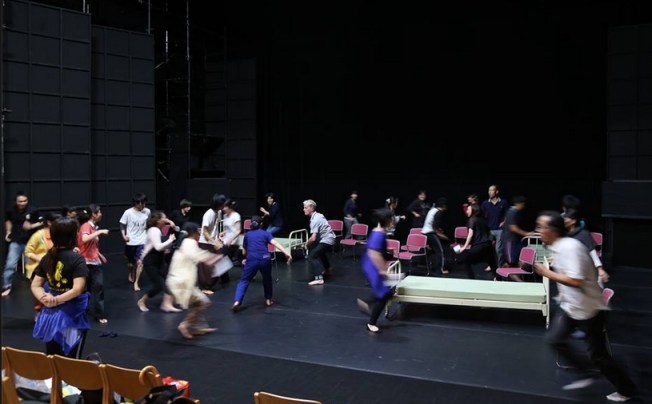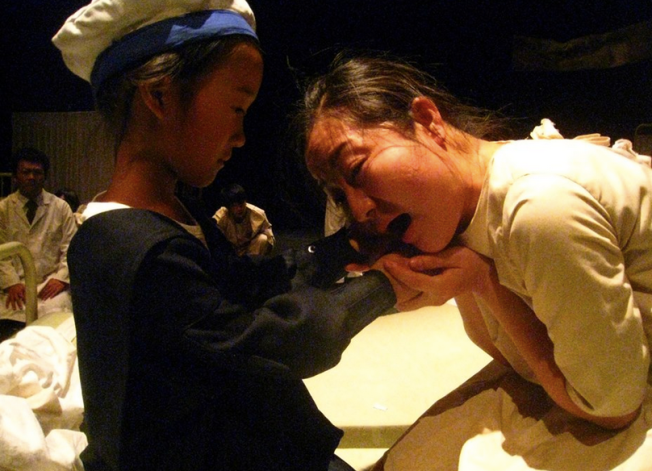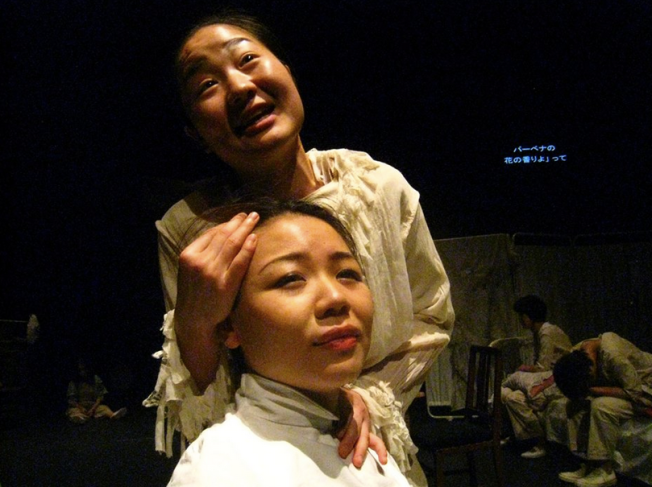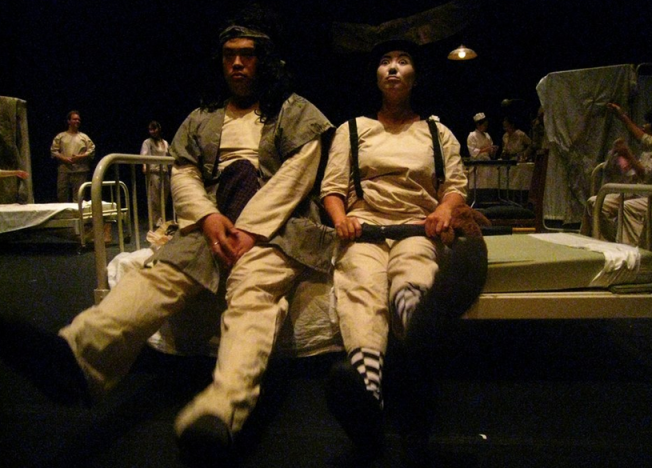Shikano, Tottori. Sept 15th 2013
The thing that first surprised all of us was that the Bird Theatre, Tottori wasn’t in Tottori City, as we’d imagined, even though it appears as part of its address. Even from the University campus on the edge of town, where I stayed for the first three days, Shikano, the actual location of the theatre, is thirty minutes drive away, whether past Lake Koyama and along the coast road or up over the ‘mountains’, depending on which route Megumi Shiozaki, native of Shikano, fabulous mezzo and our ‘Nurse Suzuki’ wished to chauffeur me in her dad’s car.
Shikano lies on a river plain, a small country town – really just a large village – surrounded by rice paddies, the approaches dotted with little clusters of plastic greenhouses and single dwellings, framed by pine clad mountains. Ignoring the major crop, it could easily have been somewhere in Austria or Italy. California even. It was late summer. The equinox. But the temperature was in the 30’s every day with blue skies.
It was also harvest time, and every morning as we cycled to the theatre from the Sanshien Ryokan, there were farmers, many old – ancient even – often female, getting the crop in, much of which was still drying on long wooden frames at the field sides. Then, towards the end of our stay, the workers were starting to burn the rice straw in earnest, once, quite dramatically in the fields beside the former Kowashigama Elementary School where Bird Theatre was giving an outdoor performance of Durrenmatt’s An Angel Comes to Babylon.
Bird Theatre Site
The building that houses Bird Theatre is at once functional, wilfully unpretentious and, at the same time, utterly magical. You approach it through Shikano village. Traditionally roofed ‘Japanese’ tiled, pretty wooden houses. Narrow but die-straight streets each flanked with two-foot deep water channels. Little gardens of clipped pine. Bonsai writ large. Some shops, and one or two bars and cafes but discreetly signed. One gleaming and brand new fire engine, parked off road. Then, finally, at the top, and itself overlooked by the Shikano ‘Castle’ on a wooded hill, a pond, we later discover, packed with huge hungry carp. Beyond that the former Shikano Elementary school that has been transformed into Bird Theatre.
It was here that Megumi Shiozaki, aged 6, started school. This autumn, leading singer with OperaMachine, she is to perform Nurse Suzuki here with an international and Japanese cast.
The building is post war. 1950’s maybe. Two storied. Forming an L shape onto a large sandy playground. But nothing has been done to gentrify it. The windows of the old school gym – which has now become the theatre – have been blocked in with undisguised sheets of silver foil or curtaining, to protect the inside from the summer sun one imagines, and all along the long side a lean-to with wood and off-cuts from set-building. This all looks very workaday.
Inside the Building
But it’s on the inside that the magic truly begins. There’s a crèche. A shop. A café – called The Café – serving sandwiches and Chiffon Cake, Ocha and Fresh Juice as well as hot meals of curry and fish; all the rooms fashioned from the old downstairs classrooms, at one end of which is the ‘office’ and at the other a high-ceilinged foyer that leads directly into the theatre itself.
In the foyer are what must have been the low chairs and dinner tables for the primary school, a coffee bar on some kind of market stall or barrow, a small end stage and on the 8 metre high facing wall the words:‘Bird Theatre Festival Tottori’ – in English – and, on shelves at various levels, carved wooden birds in various sizes. It is here that, as well as the two Sunday parties I attended, held in honour of the Festival performers and Bird Team, a number of smaller performances and showings took place during our time there.
You also become aware, as you become familiar with the space, that during the day piped in, through the sound system, is a constant background of bird-song. A lovely touch.
Bird Theatre Collective
But what strikes you most about Bird Theatre is the people who work in it. The hard-working, self-disciplined community of people within it. Their professionalism. Their absolute attention to detail. And their can-do approach to everything. One small example: we had decided to stage Butterfly in a much more formal way than we had in London, taking into account the end-on nature of the space. For this we wanted to be able to change the space from scene to scene by using – and moving – old style hospital type screens on wheels.
The Hospital Screens
When we arrived, the props/furniture team at Bird had already assembled three hospital beds and screens as per the list we’d sent from London. But at that stage the screens they’d found were the rights cream colour – but not mobile. They were quite heavy and probably unwieldy for unhurried and smooth scene changes. We asked them if they could possibly get ones with wheels…
By the next day screens with wheels had appeared but they were in a pinky white colour that did not match the overall cream/off-white colour of our set and costumes. It seems the Bird team was already aware of this and those screens were intended as a stop-gap measure – for rehearsals only – because the day after that more screens arrived, mobile and in the colour we wanted. Perfect for the job. Nothing unremarkable in that? Well, remember, Bird Theatre is in a country village…
True they have been making shows in Shikano for seven years. They have contacts in the community. They know the lie of the land. True, Tottori City is only half an hour away and true that there is an old hospital nearby that did have some of the furniture we needed for the show – though not the screens. But at any stage it would have been so easy for them to say to us: “That’s all there is”. Bird Theatre didn’t, though. They found us exactly the screens we wanted. Ones we’d never been able to find in London.
Props
And then, as the days passed, more and more amazing props arrived for our hospital. Syringes. Silvered boxes, Petrie dishes, enamel bowls… cloths, a frame with a picture of Carl Jung downloaded off the internet. And if they were unsure of any detail Ken, or one of his team, would arrive with a choice of things. Ten pictures of Karl Jung test-printed. Which one did I want? Ok. That one. And how big? To fit exactly in the frame? Or with a margin? And what colour? Sepia? Faded? Black and white? …
Sound and Lighting.
Marcello our stage manager and lighting designer had a similar experience with the lighting and sound crew: Masahiro Inaka on the lighting and Shunsuke Ishii on the sound desk. And because of the fantastic support he was getting, was able to light the show in really great detail right through to the last moments before it opened. Adding in little spots and specials. Taking out areas of light that were not needed. Likewise the sound design came up 100% from what it had been in London. A symphony of earthquakes and ominous rumbles underscoring the action. A sound Ford Ka transformed into a limousine.
Megumi Shiozaki
And, of course, we had the subtitles. These had already been translated for us by Megumi Shiozaki, the Nurse Suzuki who’d sung the role in London too – and current Shikano resident. But we had worked a couple of the scenes a little in Shikano, put in some more dialogue and a little more of the score and libretto, developing the Goro role. Could these additions be translated and put into the subtitles? Yes, says Megumi, resulting in her and the subtitle operator, unbeknown to us until the next day, staying up until four in the morning doing it. And this, the day before our first performance – Megumi has only had two hours sleep… None of that was allowed to mar her performance.
Titles
Great mention also has to be made of the subtitle operator: ‘Fujimitsu’, cueing Megumi’s translations. Each one delivered spot on. The cueing itself beautiful to watch… He had the whole show down to a T, having to deal with a complex libretto, duets, trios and chorus singing just as they would do it at the ROH and, I’m sure, no less professionally or accurately.
Everywhere you look, their collaboration was peerless. For another major example:
Costume
One or two pieces of costume got lost on the way to Japan or never made the trip at all. The Bird costume department, mainly in the form of the ever-helpful Yukari Asakura, ran them up for us, sometimes within an hour. Or a pair of trousers proving too tight for the singer, she found a perfect substitute for him from the costume store. He wanted a bow tie. A bow tie appeared. Someone found him a doctor’s head mirror. It was too beautiful – and strange – not to wear. And so he did, giving him – and the show – another level of the surreal.
Yukari also helped us to develop the Goro role. In London we had been developing the idea that ‘he’ (in reality, she, the mezzo Latana Phoung) would become a clown figure. A person who had modelled herself on Charlie Chaplin. And our kindly Jungian therapist Dr Liebermann would encourage Goro in this. So, she already had the umbrella. The big shoes. The walk. The bowler, when she arrived in Japan. But as yet, not the make-up. Yukari was straight onto the internet and within an hour or so of us telling her the idea, she had reearched Chaplin and done a whole make up tester on Latana for us to see. Improvements were suggested, mainly to do with Latana’s hair, making it much wilder around her face and under the bowler. And that was that. The effect was amazing. And very strong in the show a few days later.
Special mention should go to ‘Ken’ Wasaki. Though not a regular member of Bird Theatre, he was brought in to run the festival and oversaw all the technical aspects of the productions, including ours. And what a find they’d made. Ken turned out to be the typical ‘guy you’d want to be in a foxhole with’. Calm under pressure, no fuss, thoughtful, utterly professional, able and ever constructive in his suggestions and actions. And not afraid to reign in a jet-lagged and semi-delirious British director who was going off on one on the second day when he didn’t have one useful suggestion to offer on how to get the lighting rigged…
The Administration.
In the office was an admin team, headed by Kei Saito. We had already exchanged much great and clear email traffic with him over contracts and arrangements for our trip, but behind him was a team of volunteers and support staff who were there from first thing in the morning until late at night, dealing not only with us but the other shows that were going on as part of the 6th Festival. No detail was overlooked. Everything covered. So much was offered. I believe it made us give of our best too.
Accommodation.
We were put up in a Ryokan – the traditional Japanese style of hotel – in Shikano. The Sanshien. It had two onsen (communal baths) and mainly traditional Japanese ryokan rooms, sliding paper screens, tatami mats to sleep on etc … Fabulous. Breakfast was a feast of fish that you cooked yourself in a little iron cauldron – and rice, tofu, egg, pickles and tea – and all beautifully arranged on the table each morning. Free wifi. A beautiful garden at the back with its own carp pond…
Bikes
We even got our own bikes from the Theatre – and the hotel – all free. Each had a basket on the front, a dynamo, and its own stand. And a little wheel lock that we used if we popped into the Lawson, the 24 hour convenience store, at the end of the road. Morning and evening saw us cycling in packs the country lanes and roads around Shikano and the Bird Theatre. Idyllic. Six of us used it to go to the seaside at Hamamura on the Monday morning…
Babylon at Kawashigawa.
I was lucky enough to be able to see Bird Theatre’s own production of Durrenmatt’s An Angel Comes to Babylon. It was staged at the former Kawashigawa Elementary School up the road from Shikano but I arrived too late for a lift there and was obliged to cycle instead. It took longer than I expected and puffing up the hill towards the bridge the map said to cross, I saw the show was already in full swing – on the riverbank. One hundred plus audience, the actors with their backs to me and the river, the audience getting distracted by this Englishman wheezing and panting in the 35 degree heat. I still didn’t manage to steal the show, though…
An Angel Comes to Babylon
Was great. Even with no English subtitles there was no difficulty in following its two and a half hours. Mainly because the acting was very physical, inventive and clear. As was the staging. A real ensemble piece. Makoto, I learned later from Kei the Administrator, had created the company ten years earlier in Tokyo. But after a few years they felt frustrated with their inability to find rehearsal spaces and, I guess, their dependence on other theatres’ decisions to show their work. Like us in London. So, Makoto had come up with the solution of going back to his home prefecture, found the former Shikano Elementary School – and asked the company if they’d join him there. Seven out of nine of them agreed, moved to Tottori – and so the community began. Seven years later they are still the company. Hence the strength in their acting. None of them is formally trained. They’ve trained themselves by practice. Collectively. Co-operatively. The proof of the pudding…
Makoto Nakashima
Makoto found a solution to the perennial problem of lack of continuity, lack of community in work. By taking the company away somewhere. Many of whom weren’t originally from Tottori. But they’re still there seven years later. Actors, who also make props, run workshops, sell tickets and do all the other jobs needed. It’s what Peter Brooke never achieved for more than short periods. If, in reality and for all the hype, at all. Bird Theatre’s achievement is a credit to Makoto’s leadership, intelligence and imagination. Indeed to the whole company’s dedication and focus, that this community shows such strength in depth.
An Angel Comes to Babylon ends with the heroine, a female Christ figure sent to Babylon to make things a bit better, disillusioned and leaving it with the lowliest man in the world, the beggar Akki. In Makoto’s production this was staged with them appearing at the far end of the former Kowashigawa school playground – in a battered old truck. They are leaving Babylon behind. It made me think, firstly, of the Rasta idea of Babylon. Baby-lon. Captivity. The white man’s world. A place where you can’t have freedom. But then Makoto, who had been watching the show, walked by. And I told him how much I’d loved the piece. And then it occurred to me: He’d left Babylon too. Tokyo. Like Irrugi and Akki in the play. I shared with him my theory. Was he like Irrugi and Akki? He just smiled enigmatically.
Later, at the Sunday night party I had another word with him. ‘Makoto’, I said, ‘Have you any plans beyond Shikano?’. He looked at me with his mischievous look and replied: ‘I’ll only leave it when I die’. He’s probably now no more than 40. To me, that’s a rare clarity.
The Community.
We were brought into a community… That was really where the magic lay. Not only the community of the theatre company. But the wider community of Shikano and Tottori beyond the theatre company reaches out to and embraces. The crèche wasn’t just for the company’s children but functioned as a crèche for the whole village. At ten in the morning, mothers were there with toddlers, schoolkids were busy stuffing envelopes and as volunteers helping get mail-outs collated before sending. And then, during the day a whole lot of pensioners would turn up, hunker down in a semi-circle in the theatre foyer – and begin to practise as a choir, one man playing some kind of recorder or pipe in accompaniment. Nick Hytner eat your heart out.
The Chorus
Something has to be said about the chorus. Led by Chiaki Nishioka, and rehearsed into the music by Megumi Shiozaki, they were strong, mainly young, singers who, as far as I knew, had no specific experience of working in a physical style of theatre. Before starting, I was nervous that they might find it really quite difficult to adapt to this. A few years previously I’d worked at the Setagaya Theatre in Tokyo with young, mainly professional performers and they’d been great. Physically imaginative and creative. But that was Tokyo. How would these young people be? Many of whom had other jobs, in banks and offices? I needn’t have fretted.
The Public Workshops and Rehearsals
Over a series of three evening workshops prior to the arrival of the London/Beijing cast, the Chorus, Megumi Shiozaki, co-workshop facilitator, and I played. Name games. The ball game, Keepy-Uppy. Trust exercises and States of Intensity. As well as rehearsing parts of the show and encouraging them to each develop a character for the show. To work on being a patient or a carer. Including some in-role work where they swopped roles being long-term patients in a hospital and their own relatives nervous of the stigma of mental illness. We dealt with the matter at arms length. This was not drama therapy. But it allowed us to go quite deeply into the subject matter. Even, at one point having the who group write a letter to their neglectful relatives. And then playing the neglectful relatives being read a letter from someone else. Thanks to Professor Goto at Tottori University for giving us back-up and support with these workshops.
Post-Show Talk and Audience Feedback Sept 24
On the last day. Went well. 40 people stayed. The cast. The chorus as well. Many contributions. About the sexual nature of the production – the love scene. About social issues in Japan. Nick and Li Li, Latana and Ed made contributions. As did a surprisingly large number of the audience. All this conducted in the lovely theatre foyer… We sat among the audience – not on the little stage.
Conclusion.
Our last 48 hours was spent in Kyoto, bussing there on the 24th and staying in a boutique cabin hotel. A little bonus. But undoubtedly, the real angel dust was cast in Shikano. This sense of being welcomed into a joyful community. Not some hippy-dippy commune, but hardworking – joyfully hardworking – organised and well-run. We haven’t mentioned the delightful Emi Nakamoto, one of Kei’s team, who came to pick the cast up from Osaka Kansai. Always an Angel on our case. And others whose names we weren’t in Shikano long enough to learn, but who undoubtedly made a big contribution to the success of our show.
Finding Butterfly, the show, stepped up a couple of very big notches in Japan, thanks in no small part to the fabulous singer-actors from London, Tottori and China. But thanks, too, to Bird Theatre for the opportunity. And the massive support they gave us. We hope we gave them enough in return for this wonderful faith in, and dedication to our work.
A few shots from the 1st Dress Rehearsal:

